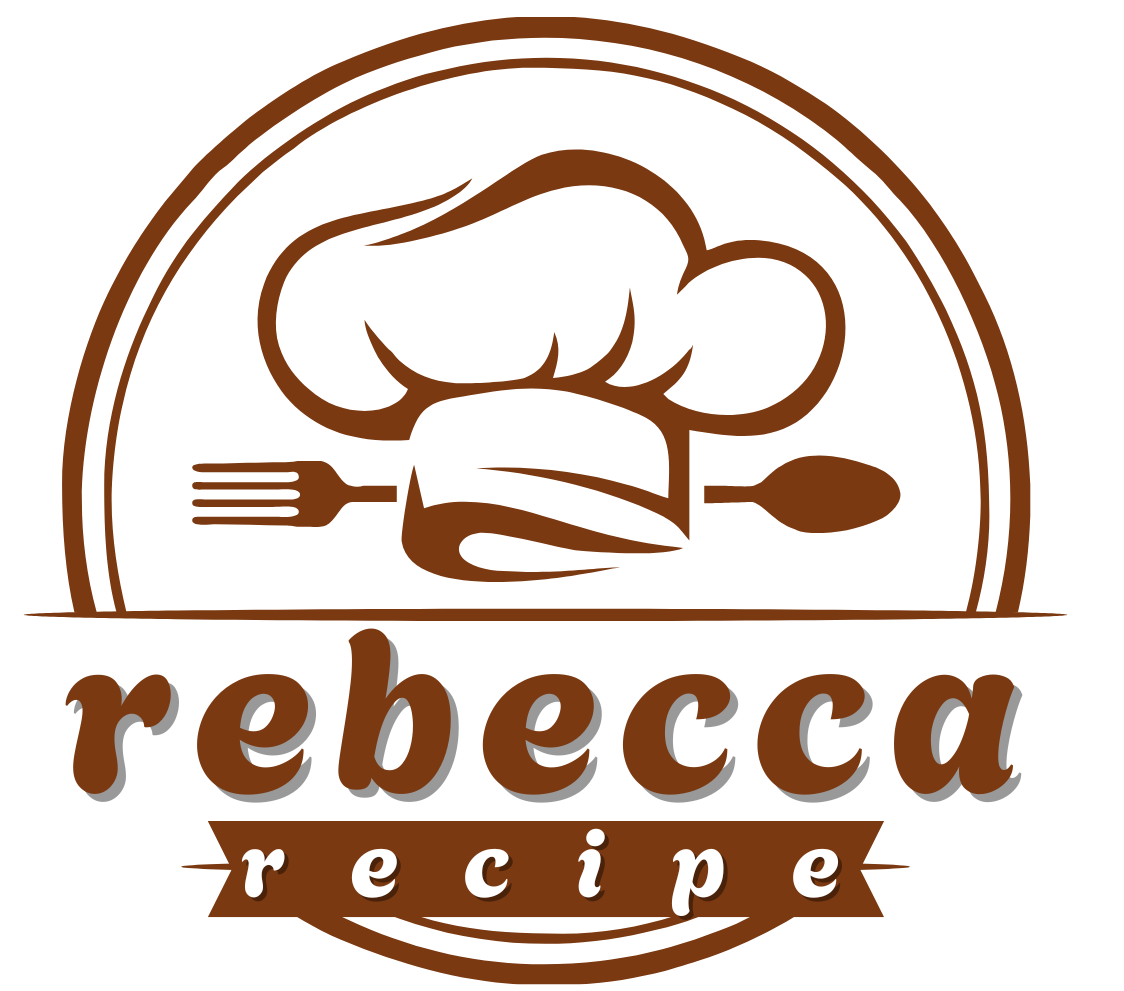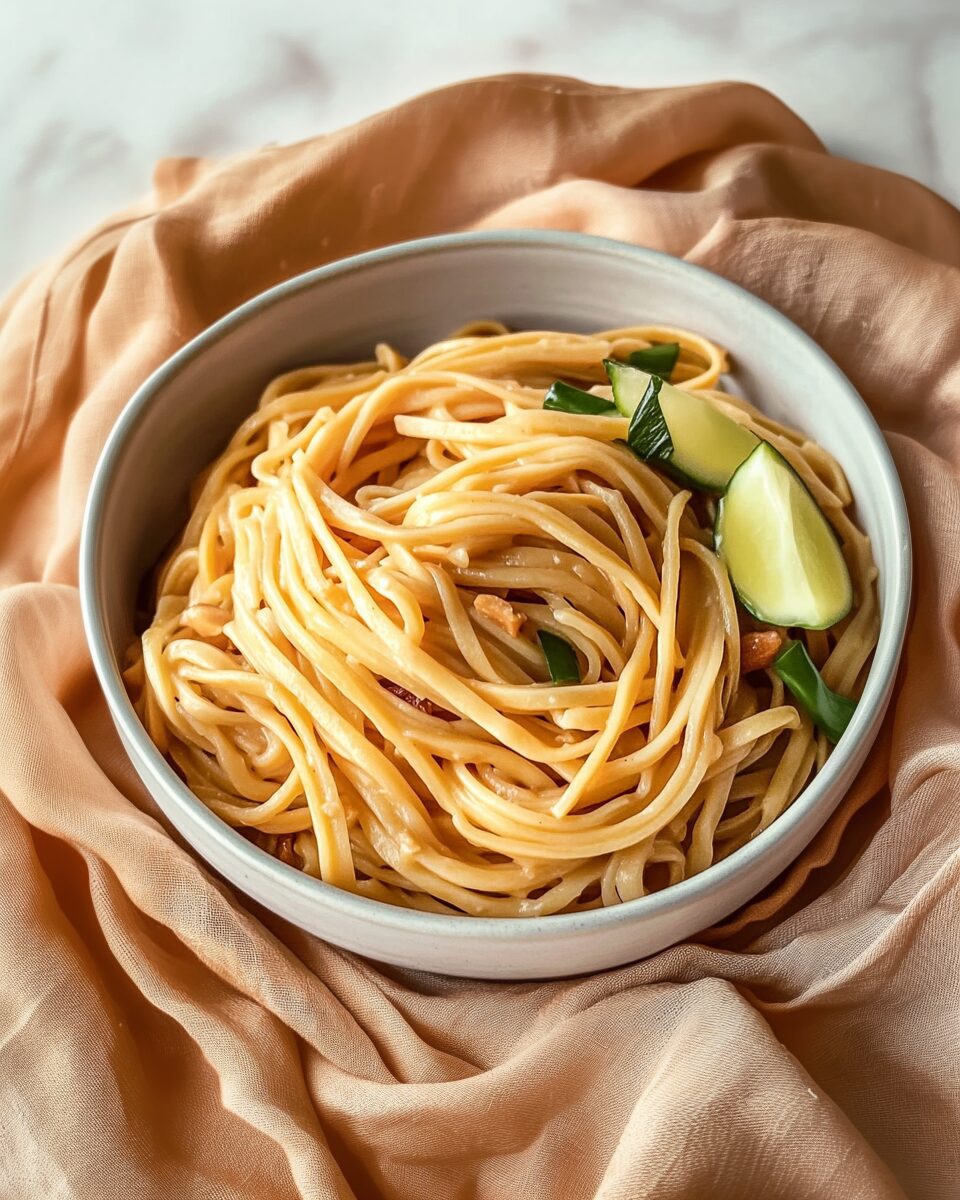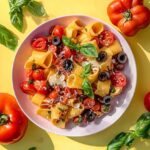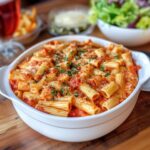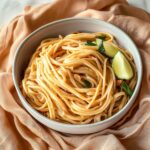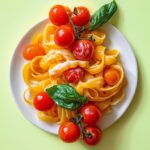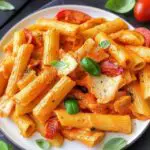Peanut noodles are a delightful fusion of creamy, savory, and slightly spicy flavors, making them a favorite in Asian-inspired cuisine. This dish features a rich, no-cook peanut sauce tossed with chewy linguine pasta and fresh vegetables, offering a satisfying meal that’s both quick and easy to prepare. Whether served warm or cold, peanut noodles are versatile enough to be enjoyed as a hearty lunch or a light dinner.
Full Recipe:
Ingredients
- For the Peanut Sauce:
- ½ cup peanut butter (smooth or chunky)
- ⅓ cup soy sauce (or tamari for gluten-free option)
- 3–4 tablespoons lime juice (freshly squeezed)
- 2 tablespoons brown sugar (or maple syrup)
- 1–2 teaspoons sriracha sauce (or preferred chili sauce)
- 1 small clove garlic (grated)
- 1 teaspoon fresh ginger (grated)
- For the Noodles:
- 200g linguine pasta (or substitute with udon, soba, rice noodles, or spaghetti)
- 1 red bell pepper (julienned)
- 1 carrot (julienned or grated)
- 1 cup red cabbage (thinly sliced)
- 1 cucumber (julienned)
- 2 scallions (sliced)
- For Garnish:
- Crushed peanuts
- Sesame oil (optional)
- Lime wedges (optional)
- Additional sriracha sauce (optional)
Directions
- Prepare the Noodles: Cook the linguine pasta according to the package instructions until al dente. Drain and rinse under cold water to stop the cooking process. Set aside.
- Make the Peanut Sauce: In a blender or mixing bowl, combine the peanut butter, soy sauce, lime juice, brown sugar, sriracha sauce, grated garlic, and grated ginger. Blend or whisk until smooth and creamy. Adjust the consistency with a little water if needed.
- Combine the Ingredients: In a large mixing bowl, toss the cooked noodles with the peanut sauce until evenly coated. Add the julienned red bell pepper, carrot, red cabbage, cucumber, and sliced scallions. Mix well to incorporate all ingredients.
- Serve: Divide the peanut noodles into serving bowls. Garnish with crushed peanuts, a drizzle of sesame oil, a squeeze of lime juice, and additional sriracha sauce if desired. Serve immediately or refrigerate for later use.
Nutrients
(Approximate values per serving, assuming 4 servings total)
- Calories: 450 kcal
- Protein: 14g
- Carbohydrates: 58g
- Sugars: 12g
- Fat: 20g
- Saturated Fat: 3g
- Fiber: 6g
- Sodium: 800mg
The Origins of Peanut-Based Sauces in Asian Cuisine
The use of peanuts in savory dishes is common across several Asian countries. In Thailand, peanut sauce is often associated with satay dishes, where skewered meats are served alongside a creamy, spicy peanut dip. In Indonesia, peanut-based sauces are integral to dishes like Gado-Gado, a vegetable salad with a rich peanut dressing. While peanut noodles as we know them today are likely a Western adaptation, they are deeply influenced by these traditional Asian flavors.
Peanuts themselves were introduced to Asia by Portuguese traders during the 16th century and have since become a staple ingredient in many Asian cuisines. Their affordability, high protein content, and rich flavor made them an essential component in both rural and urban kitchens. Today, the influence of peanuts in dishes like peanut noodles reflects a beautiful fusion of Eastern culinary traditions with Western adaptations.
Why Peanut Noodles Are So Popular
Peanut noodles have surged in popularity due to their incredible flavor, ease of preparation, and adaptability. They check all the boxes for modern food trends: they are plant-based, can be made gluten-free, packed with protein and fiber, and can be customized to suit individual taste preferences.
Moreover, peanut noodles are a comfort food. The creamy, savory sauce coats every strand of noodle, creating a hearty and satisfying mouthfeel that few other simple dishes can match. With a sauce that comes together in minutes and the ability to toss in any vegetables you have on hand, peanut noodles offer convenience without sacrificing flavor.
In addition, they are a favorite for meal preppers because they store well in the fridge and often taste even better the next day as the flavors continue to develop and meld together.
Health Benefits of Peanut Noodles
One of the standout features of peanut noodles is that they can be incredibly nutritious while still tasting indulgent. Peanuts themselves are packed with healthy fats, particularly monounsaturated fats, which are known to support heart health. They are also a good source of plant-based protein, making peanut noodles a satisfying option for those looking to reduce meat consumption.
The addition of fresh vegetables such as carrots, bell peppers, cucumbers, and red cabbage adds a significant dose of fiber, vitamins, and antioxidants. Fiber is essential for digestive health, while the vitamins and minerals in colorful vegetables boost immunity, improve skin health, and support overall well-being.
The soy sauce and lime juice used in the sauce provide additional nutrients such as potassium and vitamin C. When choosing noodles, opting for whole-grain options can further increase the fiber and nutrient content of the dish.
Finally, peanut noodles can easily be adjusted to cater to specific dietary needs, including vegan, gluten-free, and nut-free (by using alternatives like sunflower butter) diets, making them accessible to a wide audience.
Customizing Peanut Noodles to Your Taste
One of the best things about peanut noodles is their versatility. The basic concept remains the same—noodles tossed in a creamy peanut sauce—but you can vary the ingredients to suit your preferences, dietary needs, or the contents of your fridge.
Noodles: While linguine is often used for its ideal thickness and chewiness, you can swap in other types like soba, udon, rice noodles, or even spiralized vegetables for a lighter option.
Vegetables: Any crisp vegetable can be added. Common favorites include shredded carrots, sliced cucumbers, red cabbage, snap peas, and bell peppers. Roasted or steamed vegetables like broccoli, edamame, or asparagus can also enhance the dish.
Protein: Though peanut noodles are often vegan, you can easily add tofu, tempeh, seitan, or chickpeas for extra protein. For non-vegetarian versions, grilled chicken or shrimp are delicious additions.
Sauce Variations: Spice levels can be adjusted by adding more or less sriracha or chili sauce. For a sweeter note, a little maple syrup or honey can be added. If you like your sauce even richer, a splash of coconut milk can give it a luxurious texture.
These customizations ensure that peanut noodles never become boring and can be adapted to seasonal produce and personal taste preferences.
Cultural Adaptations and Global Influence
While peanut noodles draw inspiration from Asian cuisine, the dish has been embraced globally and adapted in countless ways. In American and European kitchens, peanut noodles often lean more heavily on peanut butter and soy sauce, and sometimes incorporate ingredients like sesame oil, vinegar, and sugar to create a sauce that is rich, tangy, and slightly sweet.
Fusion versions have emerged as well, including Mexican-inspired peanut noodles with the addition of avocado and jalapeño, or Mediterranean versions that incorporate sun-dried tomatoes and olives. Each cultural twist brings a new dimension to the dish, showcasing the incredible versatility of its core ingredients.
This global adaptability highlights the universal appeal of peanut noodles and ensures their continued popularity across different cuisines and dining preferences.
Serving and Presentation Tips
Peanut noodles are as much a feast for the eyes as they are for the palate. To make them visually appealing:
-
Use a variety of colorful vegetables to add vibrancy to the dish.
-
Top with a sprinkle of crushed peanuts for texture and garnish.
-
Add fresh herbs like cilantro, basil, or mint to provide a pop of green and extra flavor.
-
Drizzle with a little extra peanut sauce or sriracha before serving.
-
Serve with lime wedges on the side to allow diners to customize the level of acidity to their taste.
Presentation matters, especially if you’re serving peanut noodles at a gathering or dinner party. A beautiful bowl of peanut noodles garnished thoughtfully can turn a simple meal into a standout dish.
Storing and Reheating Peanut Noodles
Another great aspect of peanut noodles is their suitability for leftovers. Stored properly in an airtight container, they can last in the fridge for up to four days.
When storing, it’s best to keep the noodles and vegetables coated in sauce to maintain moisture and flavor. However, the sauce can sometimes thicken as it sits. To refresh the noodles, simply add a splash of water, lime juice, or soy sauce before reheating. Peanut noodles can be enjoyed cold straight from the fridge, making them a perfect grab-and-go lunch option, or lightly reheated for a warmer meal.
If you know you’ll be storing the dish for later use, consider keeping garnishes like crushed peanuts and fresh herbs separate and adding them just before serving to maintain their freshness and texture.
Why Peanut Noodles Are Perfect for Meal Prep
Meal prepping has become an essential strategy for many people managing busy schedules while trying to eat healthy, homemade meals. Peanut noodles fit perfectly into a meal prep routine because they are:
-
Quick to prepare
-
Made from affordable pantry staples
-
Easily customizable to prevent boredom
-
Durable and flavorful even after a few days
You can prepare a large batch at the beginning of the week and enjoy it for lunch or dinner without the hassle of daily cooking. Their rich flavor continues to develop over time, making each serving just as delicious, if not more so, than the last.
Peanut noodles can also be portioned into single-serving containers, making it easier to control portion sizes and maintain a balanced diet throughout the week.
Conclusion: The Enduring Appeal of Peanut Noodles
Peanut noodles have earned their place as a beloved staple for many reasons. They are a flavorful, hearty, and nutritious dish that requires minimal effort yet delivers maximum satisfaction. The creamy, savory peanut sauce combined with the satisfying texture of noodles and the freshness of vegetables creates a harmonious and crave-worthy meal.
